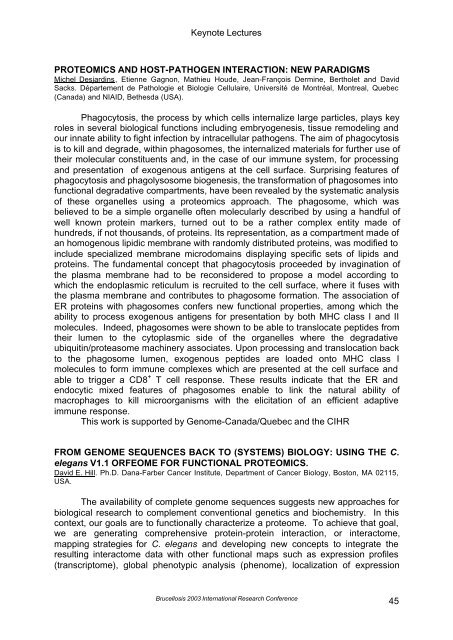Brucellosis 2003 proceedings - PHIDIAS
Brucellosis 2003 proceedings - PHIDIAS
Brucellosis 2003 proceedings - PHIDIAS
You also want an ePaper? Increase the reach of your titles
YUMPU automatically turns print PDFs into web optimized ePapers that Google loves.
Keynote Lectures<br />
PROTEOMICS AND HOST-PATHOGEN INTERACTION: NEW PARADIGMS<br />
Michel Desjardins, Etienne Gagnon, Mathieu Houde, Jean-François Dermine, Bertholet and David<br />
Sacks. Département de Pathologie et Biologie Cellulaire, Université de Montréal, Montreal, Quebec<br />
(Canada) and NIAID, Bethesda (USA).<br />
Phagocytosis, the process by which cells internalize large particles, plays key<br />
roles in several biological functions including embryogenesis, tissue remodeling and<br />
our innate ability to fight infection by intracellular pathogens. The aim of phagocytosis<br />
is to kill and degrade, within phagosomes, the internalized materials for further use of<br />
their molecular constituents and, in the case of our immune system, for processing<br />
and presentation of exogenous antigens at the cell surface. Surprising features of<br />
phagocytosis and phagolysosome biogenesis, the transformation of phagosomes into<br />
functional degradative compartments, have been revealed by the systematic analysis<br />
of these organelles using a proteomics approach. The phagosome, which was<br />
believed to be a simple organelle often molecularly described by using a handful of<br />
well known protein markers, turned out to be a rather complex entity made of<br />
hundreds, if not thousands, of proteins. Its representation, as a compartment made of<br />
an homogenous lipidic membrane with randomly distributed proteins, was modified to<br />
include specialized membrane microdomains displaying specific sets of lipids and<br />
proteins. The fundamental concept that phagocytosis proceeded by invagination of<br />
the plasma membrane had to be reconsidered to propose a model according to<br />
which the endoplasmic reticulum is recruited to the cell surface, where it fuses with<br />
the plasma membrane and contributes to phagosome formation. The association of<br />
ER proteins with phagosomes confers new functional properties, among which the<br />
ability to process exogenous antigens for presentation by both MHC class I and II<br />
molecules. Indeed, phagosomes were shown to be able to translocate peptides from<br />
their lumen to the cytoplasmic side of the organelles where the degradative<br />
ubiquitin/proteasome machinery associates. Upon processing and translocation back<br />
to the phagosome lumen, exogenous peptides are loaded onto MHC class I<br />
molecules to form immune complexes which are presented at the cell surface and<br />
able to trigger a CD8 + T cell response. These results indicate that the ER and<br />
endocytic mixed features of phagosomes enable to link the natural ability of<br />
macrophages to kill microorganisms with the elicitation of an efficient adaptive<br />
immune response.<br />
This work is supported by Genome-Canada/Quebec and the CIHR<br />
FROM GENOME SEQUENCES BACK TO (SYSTEMS) BIOLOGY: USING THE C.<br />
elegans V1.1 ORFEOME FOR FUNCTIONAL PROTEOMICS.<br />
David E. Hill. Ph.D. Dana-Farber Cancer Institute, Department of Cancer Biology, Boston, MA 02115,<br />
USA.<br />
The availability of complete genome sequences suggests new approaches for<br />
biological research to complement conventional genetics and biochemistry. In this<br />
context, our goals are to functionally characterize a proteome. To achieve that goal,<br />
we are generating comprehensive protein-protein interaction, or interactome,<br />
mapping strategies for C. elegans and developing new concepts to integrate the<br />
resulting interactome data with other functional maps such as expression profiles<br />
(transcriptome), global phenotypic analysis (phenome), localization of expression<br />
<strong>Brucellosis</strong> <strong>2003</strong> International Research Conference<br />
45
















